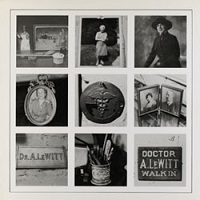Sol LeWitt
Representation, and an Audience of One
November 14, 2008–January 15, 2009

Sol LeWitt
Autobiography of Sol LeWitt
1980
New York: New York Multiples, Inc; Boston: Lois and Michael K. Torf, 1980
The Clark Art Institute Library.
Systematic networks of lines covering entire walls; geometric figures freestanding in the center of a gallery; complex instructions that require a team of artists to complete—these are often what first come to mind when considering Sol LeWitt (1928–2007). Yet there is also a portion of LeWitt’s work aimed at an intimate audience of one—the artist’s book.
LeWitt recognized early the potential benefits in distributing artistic production through low-cost publications: books offer permanence to the artistic moment that is lacking in a scheduled gallery setting; they can allow an artist deeper and more complete control of their presentation; their audience is at the same time more far reaching than an exhibition and yet very intimate to the individual viewer holding the object in his hand. As a founder in the early 1970s of Printed Matter, a bookstore devoted entirely to artists’ books and their creation, he championed affordable books as an artistic vehicle, both for his peers and for himself.
While the use of artists’ books fit nicely with the qualities of his system-driven conceptual and minimal works, they also proved uniquely suited for his little-known photographic work. Despite the representational element inherent in photography, LeWitt uses the nature of the book format to organize his images to reflect the seriality and systems that permeate his non-representational works.
The Sterling and Francine Clark Art Institute is pleased to present this special installation of works from the Clark Library on the occasion of the opening of Sol LeWitt: A Wall Drawing Retrospective at Massachusetts Museum of Contemporary Art.
Sol LeWitt
Autobiography Sol LeWitt 1980
New York, Multiples, Inc., 1980
This is perhaps the best known of LeWitt’s photographic books. It is an inventory of objects in his New York studio. Repeating the familiar format of nine uniformly sized photographs per page, the images are grouped thematically. A sense of the artist comes through, despite the total absence of text.